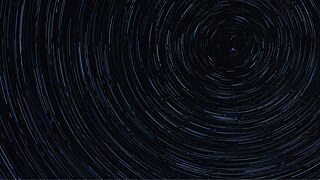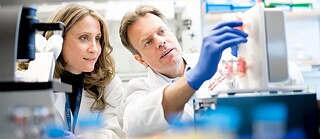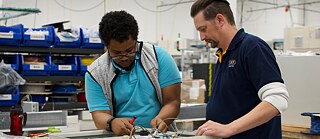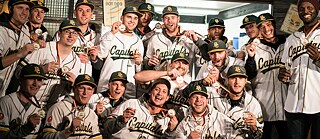Zum Forschen in die USA
Heart in Space — German Scientists and NASA
Sonja Schrepfer wäre es bis 2013 nicht in den Sinn gekommen, für die NASA zu arbeiten. Heute leiten die deutsche Kardiologin und ihr Mann Tobias Deuse das Transplant and Stem Cell Immunobiology Lab an der University of California San Francisco und forschen im Auftrag der NASA zur Raumfahrt.
Diese Folge anhören: Apple Music | Spotify | Download
Diese Folge stammt von Iris Völlnagel. Iris lebt und arbeitet als freie Fernsehjournalistin in Leipzig und Hamburg. 2015 besuchte sie zum ersten Mal das Kennedy Space Center in Cape Canaveral und war erstaunt, welche Rolle deutsche Wissenschaftler*innen bei der Entwicklung der Raumfahrt spielen. In diesem Podcast unterhält sich Iris mit den Wissenschaftler*innen Sonja Schrepfer, Tobias Deuse und Ruth Globus. Die Musik in dieser Folge „Delicate Hope – Shorts“ und „Atmospheric Drones and Soundscapes“ dürfen wir mit freundlicher Genehmigung von Sonoton verwenden. Das Foto zur Folge hat Noah Berger für die University of California in San Francisco aufgenommen, es zeigt Kardiologin Sonja Schrepfer und deren Ehemann Tobias Deuse.
Transkript
[ATMOLAUNCH: 9-8-7-6-5-4-3-2-1-0 ... IGNITION!]
Iris Völlnagel: Cape Canaveral, Florida, Kennedy Space Center. It’s December 5th, 2018. Space X has just launched its sixteenth commercial resupply mission to the International Space Station ISS. For the NASA technicians this is just another flight. For Sonja Schrepfer it’s a special one. Over the past months, the German scientist has been working hard to get her test samples, some 80 tissue chips from her lab, ready in time to send them to the ISS. Now she is in Cape Canaveral together with her team, watching the launch of the spacecraft that carries the valuable freight, one that is likely to have an impact on future space travel into orbit. A feeling that is hard to describe, Sonja Schrepfer says.
Sonja Schrepfer: We were just standing there looking at the rocket and we were told before by collaborators that we shouldn’t make any pictures, just be in the moment and enjoy the launch.
Iris Völlnagel: Since 2016 Sonja Schrepfer and her husband Tobias Deuse have been leading the Transplant and Stem Cell Immunobiology Lab at the University of California in San Francisco. It is funded by NASA, the National Institutes of Health and the Center for the Advancement of Science in Space. Schrepfer and her team study how zero gravity affects the body as well as the vascular cells and the immune system. By doing so they hope to find out what may help astronauts to survive much longer stays in space. And there is more: Hopefully the research will show new ways how patients on earth, who suffer from various diseases, could be healed — or at least find relief as doctors have a better understanding of these diseases.
Sonja Schrepfer: Our group is focused on immune cells and the cardiovascular system, but other groups are working on muscle loss, on bone loss, on brain changes or the high vasculature. So all those mechanisms will learn from the International Space Station will benefit patients on earth. Because whenever you understand the mechanisms better, that’s your first step on developing new strategies or therapeutic options.
[APPLAUSE IN THE BACKGROUND]
Iris Völlnagel: The day of the launch might be a big milestone in Sonja Schrepfer’s research. It’s the first time that she was able to send a set of about 80 tissue chips to the ISS National Lab. Tissue chips are a fairly new technology. They are bioengineered devices in the size of today’s small computer flash drives. The chips allow scientists to mimic the function of human organs and of the body’s immune system.
Sonja Schrepfer: And our group used a chip system where we rebuilt like the vascular jar, for example, and then put the vascular stem cells and the immune cells together on the chip. And the chip system allows the flexibility. You can really build it according to your scientific questions.
Iris Völlnagel: Before sending the tissue chips to space, Sonja Schrepfer and her team have conducted experiments in their labs in San Francisco and Hamburg, Germany for many years. Here, they simulated microgravity with the help of special lab equipment. But in order to confirm and validate the results, the chips have to spend time in space. Equally important: It saves a lot of time. Scientists found out that in space one can make observations over the course of just a few weeks that otherwise might take months in a lab on earth.
Sonja Schrepfer: The astronaut who handed our chips and put them into a cell incubator was Alexander Gerst. So for us it was a really nice experience that the German astronaut who was coincidentally at the same time at the ISS was putting those tissue chips into the incubator.
Iris Völlnagel: After their short but crucial space travel onboard the ISS, the tissue chips were sent back safely to the scientists on earth in January 2019. Since then, Schrepfer and her team have been evaluating the large amount of data. It’s a long process and requires a lot of patience. However, the researchers already have a better idea of the changes that occur in human cells in microgravity, and they have a first indication what the resemblance of the accelerated aging and disease processes may mean for human health.
Sonja Schrepfer: What we can confirm at this time point is that microgravity is a model for aging and aging really differentiates your immune cells and meaning that those immune cells are everywhere in your body and they have effects on your body own stem cells. And what is really interesting for us as scientists is when you return those samples back to earth, you can really investigate if aging is reversible, because you can have those tissue chips in the lab and then do your experiments if the aging processes we saw on the International Space Station can be reversed.
[CLASSICAL SPACE MUSIC]
Iris Völlnagel: So far it’s not clear what actually causes the effect of the accelerated aging in space — and Sonja Schrepfer would love to know, too. But the experienced scientist knows that one can’t take a shortcut to early conclusions: First you need to understand the problem in its full depth.
Sonja Schrepfer: If we understand what happens during aging with the immune cells, then the next step is more easier, because then you can really start thinking about what would stop the mechanism to prevent it or to reverse it. But the biggest challenge in science is to understand the underlying problems. That is what our study is really focused on: understanding what happens within the immune system in aging and how that does affect the stem cells in our body.
Iris Völlnagel: As humans prepare to venture deeper into outer space, including potential trips to Mars, researchers work hard trying to understand and mitigate the effects of low gravity and radiation on space travelers’ bodies. A trip to Mars would take at least almost two years of travel. So far, no human has spent so much time in space. No one really knows what effect prolonged microgravity will have on the human body. Scot Kelly is the American who spent the longest consecutive time in space. In March 2016, he returned from an almost one-year-long trip to the ISS.
[ANNOUNCEMENT FROM WITHIN THE RETURNING SPACECRAFT: SCOTT KELLY, SCOTT KELLY BACK ON MOTHER EARTH AFTER 340 DAYS IN SPACE.]
Iris Völlnagel: Like most other returning astronauts, Kelly was not able to leave the landing module without help. Of course, one obvious reason might be muscle loss, Sonja Schrepfer says. But it’s not the only one. Changes in the cardio vascular system are another.
Sonja Schrepfer: What happens in space is that arteries, especially the artery from the aorta to the brain, they changed in space and in microgravity. And these changes cause thickening of these arteries and the artery gets stiffer and that might be good when you are in space. But if the astronauts come back to earth, this prevents the blood to go to the brain. So when astronauts leave the capsule they can’t walk because of the muscle loss of course of the legs, but let’s say the muscle in the legs would be normal, they still would not be able to stand up and walk, because the blood flew to the brain is slower and less than normally.
Iris Völlnagel: A big problem which needs to be solved before humans can be sent to Mars. Because there, without ground crew, astronauts have to be able to leave the spacecraft by themselves and walk on their own feet right away. But there seems to be hope: Schrepfer and her team have identified a chemical molecule that prevents the changes in the blood flow when given to mice.
Sonja Schrepfer: So giving this molecule prevent the Carotid artery changes might be a solution for the astronaut that he could get out of the capsule without having that phenomenon of the Carotid artery. What the big discussion is at the moment in our lab is, we don’t know if it’s a protective mechanism of the body, because changes that happen in the Carotid artery — is that just a side effect of microgravity or is it a solution of our body to prevent our body from fluid shift, for example, that happens in microgravity?
Iris Völlnagel: To develop a medication to overcome the effects microgravity has on the human body, this may take some more years. Ruth Globus is a scientific researcher Sonja Schrepfer is working together with a lot. She believes technology will overcome this challenge.
Ruth K. Globus: The longer you stay and the farther you go, obviously the bigger the risk. There are clear health risks. The immune system is one of them where our ability to connect with medical services is quite limited. But just based on historically what’s been most profound has been, in terms of impacts on humans, has been the inability of rockets to perform reliably.
[CLASSICAL SPACE MUSIC]
Iris Völlnagel: Being a successful professor in Germany, Schrepfer never thought of working for NASA — not until 2013. Then her husband, Tobias Deuse, a cardiac surgeon, and the 44-year old scientist joined the Scientific Meeting of the American Heart Association. Before catching their flight back to Germany, the couple visited NASA Johnson Space Center in Houston. Especially the exhibition about NASA’s research and the planned Mars mission and its challenges for human beings caught their attention. At the end of the visit they received a document with a weblink to NASA’s research website. Schrepfers husband Tobias Deuse remembers:
Tobias Deuse: We were given a contact for the submission of future proposals. On our flight back we designed the studies. We then wrote a grant proposal and it underwent a pretty long review process and was finally approved. This was a first grant.
Iris Völlnagel: Their research project was born, fittingly called “Heart in Space.” Schrepfer and her husband moved from Hamburg to San Francisco. Now she actually leads two research teams, five colleagues in Hamburg, Germany, and eight in San Francisco. The time gap is a real advantage: There is always one team working, thus able to validate quickly what the team on the other side of the Atlantic has just found out. However, working in the USA and doing research for NASA is a special experience.
Tobias Deuse: The location of our lab in San Francisco, a few miles away from NASA’s Ames Research Center in Mountain View, makes it easy for us to interact and collaborate. Research becomes achievable when multidisciplinary groups team up and build strong collaborations. That is what funding agencies want to see, because it bundles expertise and increases the likelihood for success.
Iris Völlnagel: Once a week both teams come together for a Skype meeting.
[SKYPE DIALOGUE: HELLO SAN FRANCISCO, HOW’S IT GOING? HOW ARE YOU? — HI TEAM IN HAMBURG, IT’S GOING VERY WELL, THANK YOU! HOW’S THE WEATHER IN HAMBURG? — TODAY IT’S A LITTLE BIT RAINY BUT, HOWEVER … CAN YOU SEND US A LITTLE BIT OF SUN OF CALIFORNIA? — NO, I CANNOT, IT’S VERY FOGGY IN SAN FRANCISCO, SORRY! — [LAUGHING] OKAY!]
Sonja Schrepfer: The collaboration of San Francisco and Hamburg is really fantastic. The advantages as a scientist, you always want to validate your data. So if your data only work in your own lab and no one else can reproduce them, that is probably not good data. So having labs in different countries validating the data shown similar results. I think that is of great value! Also getting people with so many different backgrounds and experiences is just something that is very important for research on science to move forward.
Iris Völlnagel: It will still take some more years before the results of her research might show up in the form of a new medication to overcome the aging of cells or Carotid artery changes due to microgravity. However, it’s obvious what motivates the dedicated scientist.
Sonja Schrepfer: I am really dreaming about a Mars mission. I wouldn’t be the person who would be suitable for a Mars mission, but I’m really dreaming about this like we had it with the first moon mission like that we are really able to explore and go beyond our dreams and really explore new planets. That really excites me. And then also that those astronauts and scientists bring of course back samples and data and what they have experienced that then helps us on earth to either understand biological problems here. But also to understand more the universe and what’s out there.
Iris Völlnagel: For Sonja Schrepfer one thing is clear: One day it will be possible to send people safely and in good health to Mars — and hopefully she will be one of those who helped to make this dream become reality.







